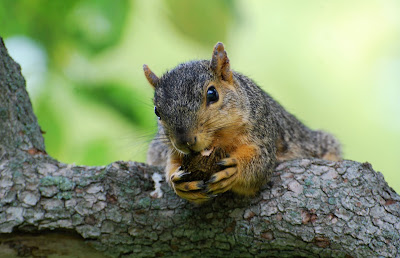Embracing the Value of Squirrels and Chipmunks in our Garden
If you are a regular or long-time reader of Southern Meadows, you know we work conscientiously to support wildlife in our garden. I often write about pollinators, birds and beneficial insects, all essential to a functioning ecosystem, but there are other critters that play an important role in this habitat that need to be considered, such as squirrels and chipmunks.
I know. I can hear your collective
sighs.
Many, perhaps most, people
consider them pests. They are known to raid bird feeders or nibble ripe fruit in the vegetable garden but from the critter’s perspective we are offering them a easy access
buffet. Why wouldn't they be regulars in our gardens? But this is not a post
on how to prevent them from taking advantage of your garden's bounty. Instead,
I want to focus on their value [services] they provide to our environment.
As I watch the squirrels and chipmunks busily collect seeds/nuts in our garden, I am reminded of their often undervalued role in our ecosystem. As they hoard nuts for the winter, they are also helping trees disperse seeds. Squirrels won't eat everything they cache, nor will they remember where they hid all the nuts, so the forgotten seeds will eventually sprout and become future trees. Essentially, they are planting seeds for the trees so maybe we should start thinking about them as nature's gardeners. This action is particularly helpful to trees that are heavy nut producers because the new trees will ultimately grow better away from the parent tree where they will receive more light.
Researchers note that evidence is accumulating that along with blue jays and a few other small animals, squirrels are important in maintaining and regenerating second-growth oak forests, and may even have been responsible for spreading the vast stands of oak throughout North America. (University Of Richmond. "Researchers Tackle The Nutty Truth On Acorns And Squirrels." ScienceDaily)
Oak trees have an interesting way of encouraging squirrels to help them. The acorns contain more lipids, a tasty fat, at the top of the
nut, which entices the squirrels. The tannins, a bitter tasting chemical, is at the bottom of the nut, which by design is where the acorn’s embryo is housed and therefore more protected.
The two major groups of oaks--red and white--have seeds that differ generally in chemical makeup. Red oak acorns are rich in fats but are laced with tannins, the compounds used to tan hides. White oak acorns are less fatty and lower in tannins. Red oak acorns lie dormant in winter and sprout in spring; white oak seeds usually sprout soon after falling to the ground in autumn. (University Of Richmond. "Researchers Tackle The Nutty Truth On Acorns And Squirrels." ScienceDaily)
There is documented proof that squirrels are largely responsible for the succession of hickory tree forests.” (Burt 102). In some ecosystems, squirrels are so enmeshed with the reproduction of pines and oaks that without them it’s possible the ecosystem could collapse.” (Holmes 72) “In Do Squirrels Matter?"
When a squirrel finds an acorn it will roll it and then shake it. What is it doing? They are evaluating the quality of the seed and deciding whether or not it’s a good one. Acorns can become infected with weevils so if the squirrel determines the acorn has weevils it will eat it immediately. If not, it will store it for later.
Squirrels are more clever than you think. Did you know that squirrels cache their nuts by type and size? They also store their most valuable stash in wide open spaces where predation risks are higher and therefore pilferage from other squirrels is lower. A clever strategy! Squirrels also practice 'deceptive caching' where they pretend to stash seeds in various places just in case other squirrels are watching. They don't want to give away their larder locations.
Just the other day I watched a squirrel with a big nut in its mouth, climb up one of our retaining walls, scamper along the top of the wall and never drop the nut. It found a desirable spot to bury it and began digging. When the squirrel reached a satisfactory depth it covered it up with soil and then replaced all the mulch. By the time it ran off I couldn't even tell the soil had been disturbed. Time will tell if the squirrel finds it again over the winter or if a tree sprouts next to our sunroom.
Even though chipmunks are in the same family as squirrels their caching behaviors are quite different. Chipmunks love to eat and forage constantly. They often scurry around the garden collecting food in their cheek pouches. They are larder hoarders, meaning they hide lots of nuts in one place.
Squirrels and chipmunks also hold a significant place in the food chain as an important food source for owls, hawks, snakes, bobcats, foxes and racoons. We have several birds of prey that call our property home. Without food they wouldn't stay around. The hawks often hang around our kitchen garden and are great at keeping the squirrels and chipmunks out of our raised beds.
The relationships between animals and plants is what makes our garden thrive and benefit all. Squirrels have a place in the landscape and the benefits they provide to the habitat far outweigh the perceived damage they may do to our gardens.
Squirrels are also good indicators of, not just contributors to, the health of a forest. “The presence, demographics, and habitat use of tree squirrels can indicate the status of forested ecosystems”, according to John L. Koprowski.












.png)